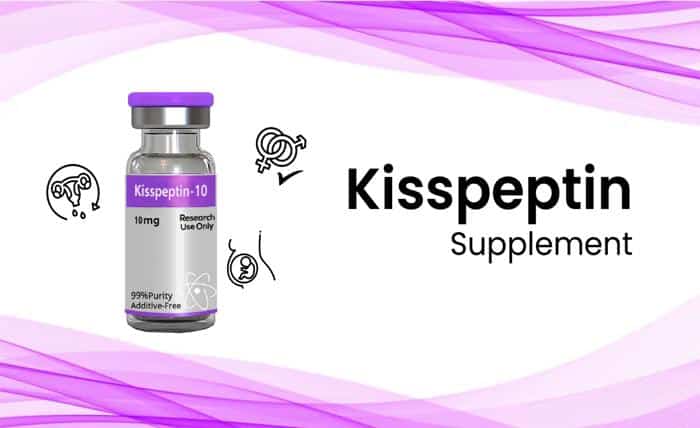
Kisspeptin-10, a prominent peptide derivative of the KISS1 gene, has emerged as a focal point in neuroendocrine research due to its possible roles in reproductive science and hypothesized impacts across multiple physiological domains, including cognition, metabolism, and neurodevelopment. While kisspeptins are a larger family of peptides, Kisspeptin-10, comprising the shortest active form, is particularly studied for its potential in binding and activating the G-protein-coupled receptor GPR54, also referred to as the kisspeptin receptor.
Through modulating this receptor, Kisspeptin-10 is speculated to exert far-reaching impacts, influencing pathways that span reproductive hormone regulation to neurogenesis. This article explores the possible implications of Kisspeptin-10 in the scientific landscape, examining its theorized roles in reproductive science, cognitive function, energy regulation, and neuroendocrine signaling.
Introduction to Kisspeptin-10 and GPR54 Activation
Kisspeptin-10 (KP-10) represents a potent segment of the larger kisspeptin family, gaining scientific interest for its potential in targeting the GPR54 receptor. Located within the hypothalamic-pituitary-gonadal (HPG) axis, GPR54 activation is crucial for signaling pathways related to reproductive science. KP-10’s affinity for GPR54 is theorized to make it influential in several key regulatory functions, notably the modulation of gonadotropin-releasing hormone (GnRH), thereby impacting downstream gonadotropins and steroid hormones.
GnRH modulation is integral to reproductive system maturation, puberty onset, and fertility processes, suggesting that KP-10 might hold significant promise in areas of reproductive science. Research further hints at KP-10’s possible implications in non-reproductive realms such as neurogenesis, stress response, and even cognitive processes like memory and learning.
Potential Roles of Kisspeptin-10 in Reproductive Research
The KISS1 gene, encoding the precursor to KP-10, appears intricately linked to the reproductive axis, suggesting potential research implications. The peptide is thought to influence GnRH release, a fundamental component of reproductive function in mammals. Studies suggest that during puberty, KP-10 may play a signaling role by initiating GnRH secretion, which then stimulates luteinizing hormone (LH) and follicle-stimulating hormone (FSH) production, essential for gonadal maturation and gametogenesis. KP-10’s potential to modulate GnRH pulsatility might theoretically aid in the context of reproductive disorders or be harnessed in novel contraceptive strategies that depend on altering reproductive hormone dynamics.
Exploring Cognitive Implications of Kisspeptin-10
While traditionally considered within reproductive contexts, recent inquiries into kisspeptins propose a potential link between Kisspeptin-10 and cognitive functions, notably within memory formation, learning, and emotional regulation. The hypothesis arises from the presence of kisspeptin receptors in areas of the brain beyond the hypothalamus, such as the hippocampus and amygdala, regions critical to cognition and affect. Research indicates that KP-10’s influence on these brain areas, while not fully elucidated, may intersect with pathways regulating stress and behavioral regulation, potentially impacting neuroplasticity and emotional processing.
Investigations have also suggested that KP-10 might support synaptic connectivity and support neurogenesis in the hippocampus. Given the hippocampus’s centrality in forming new memories and spatial navigation, the hypothesis that KP-10 may indirectly impact learning processes invites further exploration. In theory, Kisspeptin-10 might also play a role in mitigating cognitive decline associated with cellular aging or neurodegenerative conditions, making it a compelling candidate for cognitive support studies.
Metabolic and Energy Implications of Kisspeptin-10
Emerging research suggests that the KISS1 gene and Kisspeptin-10 may extend their regulatory reach to metabolic and energy pathways. KP-10’s potential role in modulating energy balance arises from its speculated influence on gonadotropin secretion, which is believed to intersect with metabolic homeostasis. Gonadotropins, LH, and FSH impact metabolism, with implications for energy expenditure and fat storage, suggesting that Kisspeptin-10 might play a role in influencing these processes indirectly.
It is theorized that KP-10 may contribute to metabolic adaptations in response to fluctuating energy demands, perhaps by modulating energy uptake efficiency, particularly within reproductive contexts. For instance, during incubation or periods of caloric restriction, hormonal shifts may trigger KP-10 activity, helping allocate resources appropriately. This theoretical model may further imply potential implications in studying metabolic disorders, such as obesity or metabolic syndrome, where energy regulation is disrupted. However, further investigation is needed to clarify KP-10’s full impact on metabolism and how it might interact with metabolic pathways.
Neuroendocrine and Stress Response Pathways
Kisspeptin-10’s interaction with the neuroendocrine system suggests it may play a role in stress response, although this hypothesis remains underexplored. The theory that KP-10 may modulate the hypothalamic-pituitary-adrenal (HPA) axis, which governs stress responses, opens intriguing questions about how this peptide might influence cortisol secretion and related stress hormones. It is posited that KP-10 might exert a balancing impact on HPA axis responses, potentially serving as a regulatory checkpoint to support overstimulation during chronic stress scenarios.
The theoretical impact of Kisspeptin-10 on stress modulation may lend insight into novel approaches targeting chronic stress or stress-related disorders. Some researchers suggest that KP-10 might be involved in modulating resilience to stress, impacting overall homeostasis and functional outcomes. Furthermore, given that stress hormones impact reproductive function, Kisspeptin-10’s interplay with both the HPA and HPG axes positions it as a molecule of interest in understanding how reproductive science and stress resilience are biologically intertwined.
Future Directions and Research Potential
While KP-10’s influence across reproductive and neuroendocrine pathways is becoming clearer, the peptide’s full potential and implications remain rich fields for discovery. For example, the potential cognitive impacts of KP-10 invite further investigation into its implications for learning and memory support. Additionally, KP-10’s proposed metabolic influence hints at a complex regulatory role that may be harnessed for addressing metabolic imbalances or metabolic resilience under stress.
In reproductive science, KP-10’s modulatory influences on GnRH might be further examined as a foundation for new fertility agents or as an alternative to current hormonal approaches that lack precision targeting. Research into KP-10’s hypothesized role in stress regulation and emotional processing may additionally catalyze developments in neuropsychiatry, where stress resilience and emotional balance are crucial.
Conclusion
Kisspeptin-10 is a compelling peptide with possible implications in reproductive science, cognitive function, metabolic regulation, and stress response. Its affinity for the GPR54 receptor and its hypothesized signaling faculty within the HPG and HPA axes suggest it might be pivotal in understanding and potentially modulating these complex biological systems. As researchers delve further into Kisspeptin-10’s multifaceted impacts, it may yield new insights and possibilities across various domains, underscoring the peptide’s significance in advancing scientific knowledge and innovation. For more informative papers visit this Kisspeptin-10 study.





